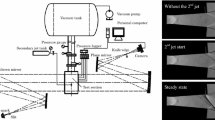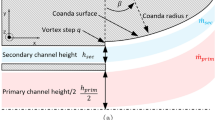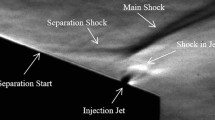Abstract
The paper focuses on a computational method for the investigation of Fluidic Thrust Vectoring (FTV). Thrust vectoring in symmetric nozzles is obtained by secondary flow injections that cause local flow separations, asymmetric pressure distributions and, therefore, the vectoring of the primary jet thrust. The methodology proposed here can be applied for studying numerically most of the strategies for fluidic thrust vectoring, as shock-vector control, sonic-plane skewing and the counterflow method. The computational technique is based on a well-assessed mathematical model. The flow governing equations are solved according to a finite volume discretization technique of the compressible RANS equations coupled with the Spalart-Allmaras turbulence model. Second order accuracy in space and time is achieved using an Essentially Non Oscillatory scheme. For validation purposes, the proposed numerical tool is used for the simulation of thrust vectoring based on FTV strategies as the shock vector control and the dual-throat nozzle concept, with a special attention to the latter case. Nozzle performances and thrust vector angles are computed for a wide range of nozzle pressure ratios and secondary flow injection rates. The numerical results obtained are compared with the experimental data available in the open literature.
Similar content being viewed by others
References
S. Asbury and F. Capone, “High-Alpha Vectoring Characteristics of the F-18/HARV”, Journal of Propulsion and Power, Vol. 10, No. 1, 1994.
P. Wilde, W. Crowther, A. Buonanno and A. Savvaris, “Aircraft Control Using Fluidic Maneuver Effectors”, AIAA paper 2008-6406, 26th AIAA Applied Aerodynamics Conference, August 2008.
M. Mason and W. Crowther, “Fluidic Thrust Vectoring for Low Observable Air Vehicles”, AIAA paper 2004-2210, 2nd AIAA Flow Control Conference, July 2004.
K.A. Deere, “Summary of Fluidic Thrust Vectoring Research Conducted at NASA Langley Research Center”, AIAA paper 2003-2800, 21st AIAA Applied Aerodynamics Conference, June 2003.
K.A. Deere, B.L. Berrier, J.D. Flamm and S.K. Johnson, “A Computational study of new dual throat fluidic thrust vectoring nozzle concept”, AIAA paper 2005-3502, 41st AIAA Joint Propulsion Conference, July 2005.
J.D. Flamm, K.A. Deere, M.L. Mason, B.L. Berrier and S.K. Johnson, “Design Enhancements of the Two-Dimensional, Dual Throat Fluidic Thrust Vectoring Nozzle Concept”, AIAA Paper 2006-3701, 3rd AIAA Flow Control Conference, June 2006.
K.A. Deere, J.D. Flamm, B.L. Berrier and S.K. Johnson, “Computational Study of an Axisymmetric Dual Throat Fluidic Thrust Vectoring Nozzle for a Supersonic Aircraft Application”, AIAA paper 2007-5085, 43rd AIAA Joint Propulsion Conference, July 2007.
R. Balu, A.G. Marathe, P.J. Paul and H.S. Mukunda, “Analysis of Performance of a Hot Gas Injection Thrust Vector Control System”, Journal of Propulsion and Power, Vol. 7, pp. 580–585, 1991.
C.J. Anderson, V.J. Giuliano and D.J. Wing, “Investigation of Hybrid Fluidic/Mechanical Thrust Vectoring for Fixed-Exit Exhaust Nozzles”, AIAA Paper 97-3148, 33rd Joint Propulsion Conference, July 1997.
J.D. Flamm, “Experimental study of a nozzle using fluidic counterflow for thrust vectoring”, AIAA Paper 98-3255, July 1998.
R. Deng and H.D. Kim, “A study on the thrust vector control using a bypass flow passage”, Proc. Inst. Mech. Eng., Part G: Journal of Aerospace Engineering, Vol. 229, No. 9, pp. 1722–1729, 2015.
R. Deng, F. Kong and H.D. Kim, “Numerical simulation of fluidic thrust vectoring in an axisymmetric supersonic nozzle”, Journal of Mechanical Science and Technology, Vol. 28, No. 12, pp. 4979–4987, 2014.
R. Deng, T. Setoguchi and H.H. Kim, “Large Eddy Simulation of Shock Vector Control using Bypass Flow Passage”, International Journal of Heat and Fluid Flow, available online before print, pp. 1–8, 2016
P. Yagle, D. Miller, k. Ginn and J. Hamstra, “Demonstration of Fluidic Throat Skewing for Thrust Vectoring in Structurally Fixed Nozzles”, ASME Journal of Engineering for Gas Turbines and Power, Vol. 123, No. 3, pp. 502–507, 2001.
R. Gu, J. Xu and S. Guo, “Experimental and Numerical Investigations of a Bypass Dual Throat Nozzle”, ASME Journal of Engineering for Gas Turbines and Power, Vol. 136, pp. 084501, 2014
R. Gu and J. Xu, “Dynamic Experimental Investigations of a Bypass Dual Throat Nozzle”, ASME Journal Engineering for Gas Turbines and Power, Vol. 137, No. 8, pp. 084501–6, 2015.
M. Ferlauto and R. Marsilio, “A Numerical Method for the Study of Fluidic Thrust-Vectoring”, Advances in Aircraft and Spacecraft Science, Vol. 3, No. 4, pp. 1–12, 2016.
M. Ferlauto and R. Marsilio, “A Computational Approach to the Simulation of Controlled Flows by Synthetic Jets Actuators”, Advances in Aircraft and Spacecraft Science, Vol. 2, No. 1, pp. 77–94, 2014.
C.A. Bright, S.L Tuttle and A.J. Needly, “The Effect of Vacuum on Shock Vector Control performance”, 19th Australian Fluid Mechanics Conference, Melbourne, Australia, 2014.
P. Spalart and S. Allmaras, “A One-Equation Turbulence Model for Aerodynamic Flows”, La Recherche Aerospatiale, Vol. 1, pp. 5–21, 1994.
P. Spalart, F. Johnson and S. Allmaras, “Modifications and Clarifications for the Implementation of the Spalart-Allmaras Turbulence Model”, Paper ICCFD7-1902, 7th International Conference on Computational Fluid Dynamics, Big Island, Hawaii, 2012.
A. Harten, B. Engquist and S. Osher, “Uniformly High-Order Accurate Essentially Non-Oscillatory Schemes III”, Journal of Computational Physics, Vol. 71, pp. 231–303, 1987.
M. Ferlauto and R. Marsilio, “A Viscous Inverse Method for Aerodynamic Design”, Computer & Fluids, Vol. 35, No. 3, pp. 304–325, 2006.
M. Ferlauto and S. Rosa Taddei, “Reduced Order Modelling of Full-Span Rotating Stall for the Flow Control Simulation of Axial Compressors”, Proc. Inst. Mech. Eng. Part A: Journal of Power and Energy, Vol. 229, No. 4, pp. 359–366, 2015.
C. Ferrat and R. Marsilio, “A Computational Method for Combustion in High Speed Flows”, Computer & Fluids, Vol. 70, pp. 44–52, 2012
E.F. Toro, “Riemann Solvers and Numerical Methods for Fluid Dynamics. A Practical Introduction”, Springer-Verlag Berlin, 2009
M. Pandolfi, “A Contribution to the Numerical Prediction of Unsteady Flows”, AIAA Journal, Vol. 22, pp. 37–46, 1983.
T.J. Poinsot and S.K. Lele, “Boundary Conditions for Direct Simulations of Compressible Viscous Reacting Flows”, Journal of Computational Physics, Vol. 101, pp. 104–129, 1992.
Author information
Authors and Affiliations
Rights and permissions
About this article
Cite this article
Ferlauto, M., Marsilio, R. Numerical Simulation of Fluidic Thrust-Vectoring. Aerotec. Missili Spaz. 95, 153–162 (2016). https://doi.org/10.1007/BF03404724
Published:
Issue Date:
DOI: https://doi.org/10.1007/BF03404724




